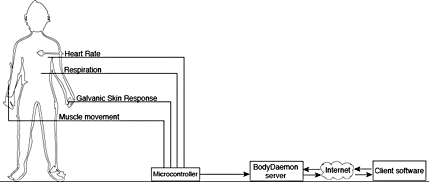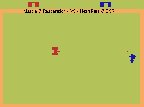June 13, 2006
BodyDaemon: A Bio-Responsive Internet Server

BodyDaemon, by Carlos Castellanos, is a bio-responsive Internet server. Readings taken from a participant's physical states, as measured by custom biofeedback sensors, are used to power and configure a fully-functional Internet server. For example, more or fewer socket connections are made available based on heart rate, changes in galvanic skin response (GSR) can abruptly close sockets, and muscle movements (EMG) can send data to the client. Other feature's such as logging can be turned on or off depending on a combination of factors.
BodyDaemon also includes a client application that makes requests to the BodyDaemon server. The client requests and server responses are sent over a "persistent" or open socket. The client can thus use the data to continuously visualize, sonify or otherwise render the live bio-data. This project is part of larger investigations focusing on the development of protocols for the transfer of live physiological and biological information across the Internet.
BodyDaemon represents the early stages of investigations into the viability of systems that alter their states based off of a person's changing physiological states and intentions - with the ultimate goal of accommodating the development of emergent states of mutual influence between human and machine in a networked ecosystem. [via Switch 22]
Two clients have been developed for BodyDaemon:
1. Combat by John Bruneau

Combat is a game developed by Atari in 1977. It runs on the Atari 2600 home consol system. Two tanks, each controlled by a different player, battle it out in a single screen arena. The pixels are big and mighty and carry with then a good helping of nostalgia.
The task of controlling each tank in Combat is split between two body statistics. One controls steering and the other controls thrust and shooting. All actions are determined by the rise and fall of each stat. For example, if heart rate was in charge of steering then a drop in the user’s heart rate would cause that particular tank to turn right, and I raise in heart rate would cause that tank to turn left. Each round ends after 2 minutes, 16 seconds at which point the next round starts and new teams are formed.
The Combat Client was created with Max/MSP, Jitter, and Javascript. It utilizes two key externals, in order to function. The first of which is the OSC and UDP objects by Matt Wright which allow Max/MSP to communicate with the BodyDaemon server. The other external is jit.atari2600, an Atari 2600 emulator/manipulator object written by Kyle Buza. This external allows me to directly access the original Atari Combat game ROM.
2. Gravitons and Graviolis by Aaron Siegel

Gravitons and Graviolis is specifically designed to translate the signals from the bodydaemon server in a manner creating a simulated orbital system of particles. The signals are transposed in the corresponding manner:
EKG: speed of particles
GSR: range of hue of particles
Respiration: number of particles on the stage
EMG: disable background drawing to allow for "pixel painting"
Preliminary code sketching was done in anticipation of this project in the form of gravitons and graviolies.
For more information on this project visit the following web sites:
ccastellanos.com, wiki.ccastellanos.com
John Bruneau's client
Aaron Siegel's client
BodyDaemon will be exhibited at ZeroOne/ISEA2006 this summer.
Posted by jo at June 13, 2006 10:00 AM
